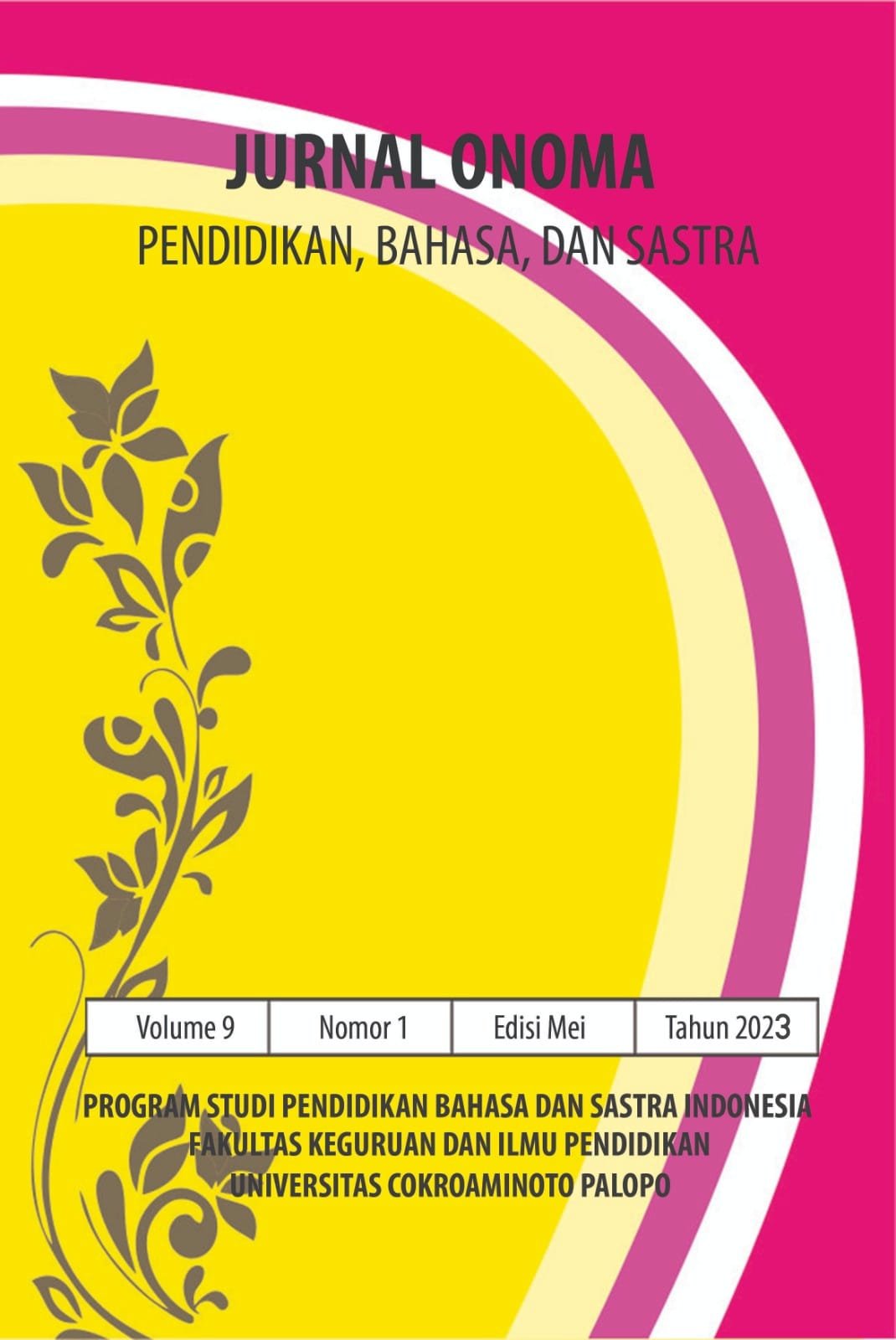Strategi Penerjemahan Lagu dalam Sulih Suara Bahasa Indonesia di Film Moana
https://doi.org/10.30605/onoma.v9i1.2452
Keywords:
Penerjemahan, Strategi Penerjemahan Lagu, Strategi Penerjemahan Sulih Suara, Strategi Penerjemahan FilmAbstract
Penerjemahan memiliki banyak jenis disesuaikan dengan wacana atau materi yang diterjemahkan. Salah satu penerjemahan yang populer dan sering dilakukan adalah penerjemahan film dan lagu. Film musikal adalah film yang menggabungkan dua jenis penerjemahan itu. Salah satu contoh film itu adalah film Moana. Penerjemahan lagu dalam bentuk sulih suara perlu penyesuaian terhadap strategi penerjemahan yang akan digunakan. Penelitian ini bertujuan untuk mengklasifikasikan strategi penerjemahan yang digunakan untuk lagu-lagu dalam sulih suara bahasa Indonesia di film Moana. Rancangan kualitatif deskriptif digunakan untuk menjawab rumusan masalah dengan sumber data empat lagu dari film Moana versi Bahasa Inggris dan versi terjemahan sulih suara Bahasa Indonesia. Data yang didapatkan sebanyak 126 data untuk masing-masing versi. Analisis deskriptif data menggunakan teori strategi penerjemahan puisi Lefevere. Dari data yang dianalisis, penerjemahan sulih suara dari lagu-lagu film Moana menggunakan lima strategi. Strategi penerjemahan metrikal mendominasi dengan penggunaan sebanyak 46%. Lalu, penerjemahan bait kosong (23, 8%), penerjemahan interpretasi (11,9%), fonemik (11,1%), dan terakhir harfiah dengan 7,1%.
Downloads
References
Anwar, F. Z. (2020). Strategies and techniques of translation in translating songs as 21st century curriculum. Manajemen Pendidikan 15(1), 35-43. DOI: 10.23917/mp.v15i1.10744
Allman, S., & Medeiros, J. L. (2020). Rotten tomatoes and chill? MRAs and their impact on decision-making. The iJournal 6(1), 1-18. DOI: https://doi.org/10.33137/ijournal. v6i1.35269
Buarqoub, I. A. S. (2019). Language barriers to effective communication. Utopía y Praxis Latinoamericana 24(1), 64-77. Dapat diakses melalui: https://produccioncientificaluz.org/index.php/utopia/article/view/30060
Bunch, R. (2021). Soaring into song: Youth and yearning in animated musicals of the Disney Renaissance. American Music 39(2), 182-195. DOI:https://doi.org/ 10.5406/americanmusic.39.2.0182
Chang, Y. (2012). Tentative analysis of English film translation characteristics and principles. Theory and Practice in Language Studies 2(1), 71-76. DOI: 10.4304/tpls.2.1.71-76
Dewi, H. D. (2022). Praktik penerjemahan dasar: Penerjemahan beberapa jenis teks. Bandung, Indonesia: Manggu Makmur Tanjung Lestari.
Hendra. (2019). Translation strategy on “Let it Go” songs that was sung by Indina Menzel in Indonesian version. Journal of English Language Teaching and Literature 2(2), 101-109. DOI: https://doi.org/10.47080/jeltl.v2i2.622
Lefevere, A. (1975). The translation of poetry: Some observations and a model. Comparative Literature Studies 12(4), 384-392. Amerika Serikat: Penn State University Press.
Matkivska, N. (2014). Audiovisual translation: Conception, types, characters’ speech and translation strategies applied. KALBŲ STUDIJOS 25(1), 38-44. DOI: http://dx.doi.org/10.5755/j01.sal.0.25.8516
Putri, H. U., Hidayati., Irwandi., & Ilham. (2022). Translating analysis of subtitle and dubbing Japan Song into Indonesian Version at a Cartoon Movie “Doraemon”. International Social Sciences and Humanities UMJember Proceeding Series 2(1), 77-83.
Rijali, A. (2018). Analisis Data Kualitatif. Jurnal Alhadharah 17(33), 81-95. DOI: http://dx.doi.org/10.18592/alhadharah.v17i33.2374
Suparman, S. (2019). Transkripsi Fonetis Cerita Rakyat Massenrempulu. Jurnal Onoma: Pendidikan, Bahasa, Dan Sastra, 5(1), 314-327.
Shuttleword, M. (2014). Dictionary of translation studies. Inggris: Routledge.
Supardi, M., & Putri, D. A. (2018). Audio-visual translation: Subtitling and dubbing technique-Movie soundtrack in Frozen: Let it Go. Buletin Al-Turas 24(2), 381-397. DOI: 10.15408/bat.v24i2.8621
Suparman, S., & Charmilasari, C. (2017). Analysis of Phase Structure Realization in Classroom Discourse: A Study of Systemic Functional Linguistics. Ethical Lingua: Journal of Language Teaching and Literature, 4(2), 120-126.
Downloads
Published
How to Cite
Issue
Section
License
In submitting the manuscript to the journal, the authors certify that:
- They are authorized by their co-authors to enter into these arrangements.
- The work described has not been formally published before, except in the form of an abstract or as part of a published lecture, review, thesis, or overlay journal.
- That it is not under consideration for publication elsewhere,
- That its publication has been approved by all the author(s) and by the responsible authorities – tacitly or explicitly – of the institutes where the work has been carried out.
- They secure the right to reproduce any material that has already been published or copyrighted elsewhere.
- They agree to the following license and copyright agreement.
License and Copyright Agreement
Authors who publish with Onoma Journal: Education, Languages??, and Literature agree to the following terms:
- Authors retain copyright and grant the journal right of first publication with the work simultaneously licensed under Creative Commons Attribution License (CC BY 4.0) that allows others to share the work with an acknowledgment of the work's authorship and initial publication in this journal.
- Authors are able to enter into separate, additional contractual arrangements for the non-exclusive distribution of the journal's published version of the work (e.g., post it to an institutional repository or publish it in a book), with an acknowledgment of its initial publication in this journal.
- Authors are permitted and encouraged to post their work online (e.g., in institutional repositories or on their website) prior to and during the submission process, as it can lead to productive exchanges, as well as earlier and greater citation of published work.

















